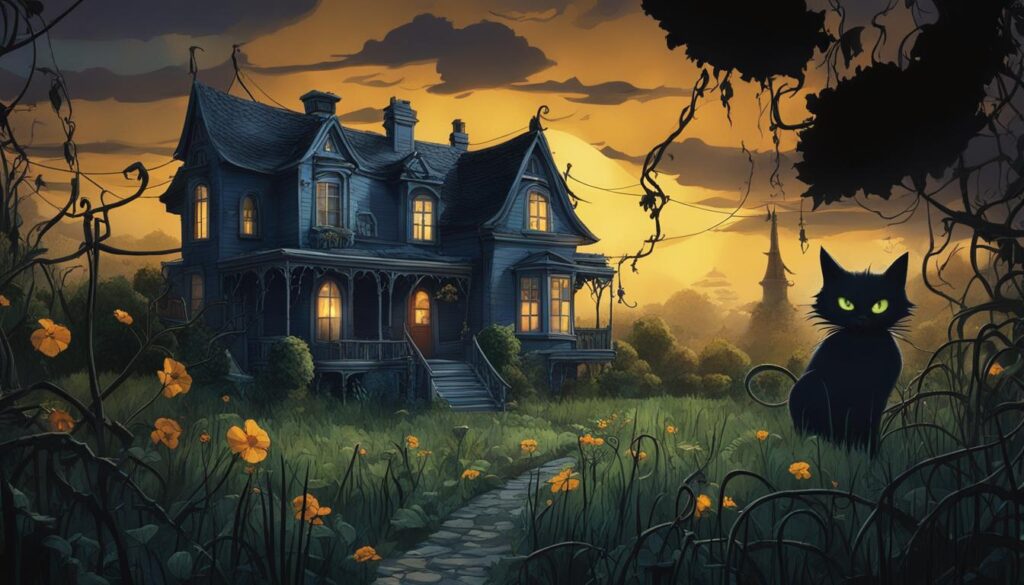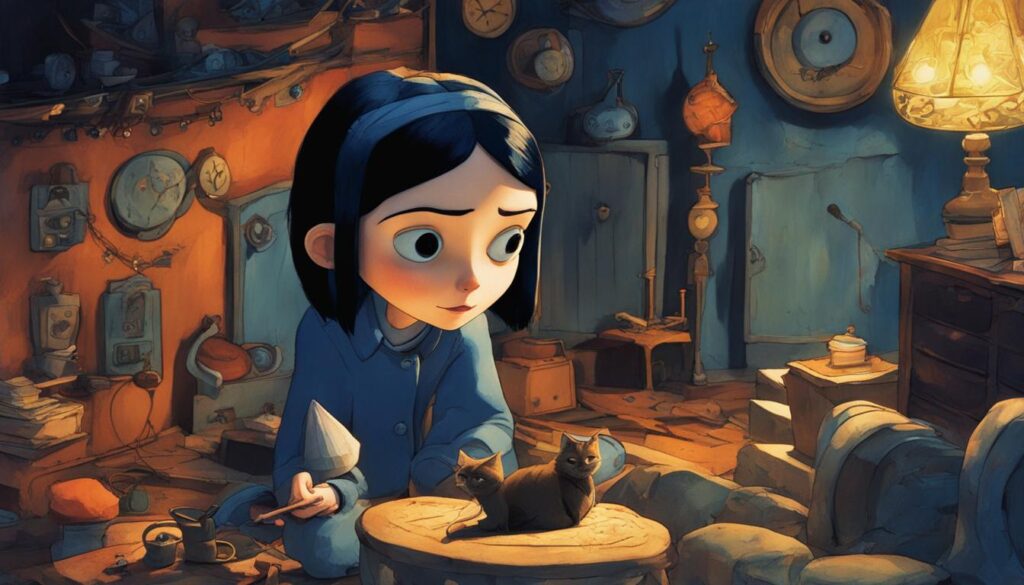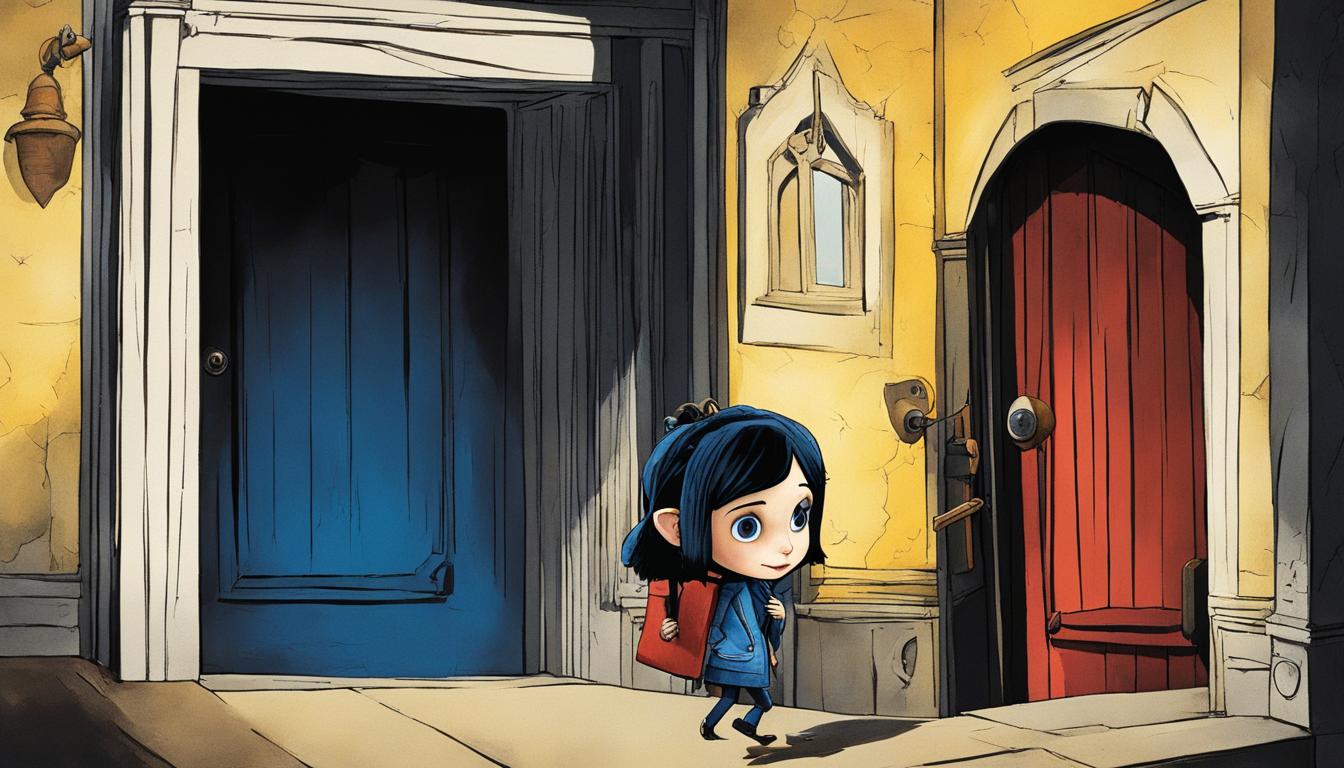Neil Gaiman’s Coraline is a tale of adventure, courage, and the power of imagination. First published in 2002, the book has become a modern classic in the genre of children’s literature. This article provides a summary of the book, highlighting its themes, characters, and setting.
Key Takeaways
- Neil Gaiman’s Coraline is a captivating tale of bravery and adventure.
- The book’s themes include courage, identity, and the power of imagination.
- Coraline has received critical acclaim and has been adapted into an animated film.
- Gaiman’s distinctive writing style creates a suspenseful atmosphere throughout the book.
- For readers who enjoyed Coraline, Gaiman has other notable works that resonate with similar themes and storytelling techniques.
Introduction to Coraline
Neil Gaiman’s Coraline is a dark fantasy novel that was first published in 2002 and has since become a beloved classic in the genre. Set in an eerie parallel universe, the book tells the story of Coraline Jones, a young girl who must navigate a world that is both alluring and dangerous.
The book’s themes of bravery, identity, and the power of imagination make it a compelling read for both children and adults. Neil Gaiman’s vivid descriptions of the setting and characters draw readers into the story and keep them captivated until the very end.
“‘Because,’ she said, ‘when you’re scared but you still do it anyway, that’s brave.'” -Neil Gaiman, Coraline
The book’s complex characters also add depth to the story, with Coraline’s courage and determination inspiring readers to confront their own fears and take on challenges with bravery.
Key Themes in Coraline
The key themes in Coraline include bravery, identity, imagination, and the importance of family. Coraline’s journey in the parallel world teaches her important lessons about herself and her relationships, making the book a powerful coming-of-age story.
The eerie and imaginative setting of Coraline further immerses readers in the story, adding to the overall appeal of the book.
As we continue to explore the book in this article, we’ll delve deeper into the plot, characters, and themes of Coraline, highlighting the reasons why this book is a must-read for all fans of dark fantasy literature.
Plot Overview
Neil Gaiman’s Coraline follows the story of a young girl named Coraline Jones, who moves to a new home and discovers a mysterious door that leads her to a parallel universe. In this eerie other world, Coraline encounters alternate versions of her parents and neighbors, and she soon realizes that her other mother and father are not what they seem.
As Coraline navigates this treacherous realm, she must use her bravery and wits to discover the true nature of this alternate reality and find a way to escape back to her own world. Along the way, Coraline faces numerous obstacles and challenges, including a sinister group of rat-like creatures and a terrifying showdown with the Other Mother.
With its captivating blend of mystery, horror, and adventure, Coraline is a thrilling read that will keep readers on the edge of their seats from start to finish.
Main Characters
Neil Gaiman’s Coraline boasts a cast of unique and memorable characters that help bring the story to life. The eponymous Coraline Jones is a curious, adventurous young girl who discovers a mysterious doorway to an alternate universe that seems initially better than her own. However, as she soon discovers, this new world hides a sinister secret that threatens her very existence.
Other key characters in the book include:
| Character | Description |
|---|---|
| Wybie Lovat | A quirky and talkative boy who lives in Coraline’s apartment building and becomes her companion in the parallel world |
| The Other Mother | The sinister, doppelganger of Coraline’s real mother, who will stop at nothing to keep Coraline trapped in the parallel world |
| The Cat | A mysterious black cat who acts as a guide and protector for Coraline on her adventures |
| Miss Spink and Miss Forcible | Two eccentric, elderly women who live in the apartment building and claim to be former actresses |
Each of these characters plays a crucial role in the story, with their unique personalities and motivations driving the plot forward and keeping readers engaged. Through their interactions with Coraline, readers gain a deeper understanding of the dangers and wonders of the parallel world and the courage it takes to confront them.
Setting
One of the most captivating aspects of Coraline is its unique and haunting setting, which effortlessly blends together elements of wonder, curiosity, and danger. The book primarily takes place in Coraline’s new home, a mysterious old mansion filled with secret passageways and hidden doors. As she navigates this strange house, Coraline discovers a hidden parallel universe, complete with a twisted version of her own life and a sinister set of “other” parents who will stop at nothing to keep her there.
The author, Neil Gaiman, masterfully creates an atmosphere of suspense, using the setting to build tension and keep readers on edge. His vivid descriptions of the house and the surrounding landscape serve to immerse readers in the world of Coraline, as they explore the hidden depths of a parallel universe brimming with danger and intrigue.

The House
The location where much of the action takes place is Coraline’s new house, which is described as a rambling old mansion that is both grand and eerie. The house is filled with winding corridors, creaky floorboards, and curious secrets, creating an atmosphere of both wonder and unease. From the creepy basement with its rusted old well to the attic filled with mysterious trinkets, the house is a character in and of itself, serving as a constant reminder that Coraline is not in a world she fully understands.
The Other World
The parallel universe Coraline uncovers is a twisted reflection of her own familiar world, with each of the characters transformed into grotesque, exaggerated versions of themselves. The world is dark, ominous, and oppressive, with the other version of Coraline’s parents trying to keep her trapped there forever. As Coraline navigates this hazardous world, she realizes that it is up to her to find a way out and back to reality.
Themes
Coraline is a powerful book that explores several thought-provoking themes, including bravery, identity, and the power of imagination. Throughout the book, Gaiman challenges readers to confront their fears and self-doubts, encouraging them to embrace their unique strengths and potential.
Bravery is a recurring theme in the book, as Coraline learns to confront her deepest fears and overcome seemingly insurmountable obstacles. This theme is reinforced through various characters in the book who demonstrate courage in the face of danger.
Identity
Another central theme of Coraline is identity, as Coraline struggles to discover her true self in a world that seems intent on shaping her into something she is not. This theme is developed through Coraline’s interactions with various characters, each of whom represents a different aspect of her personality.
“‘When you’re scared but you still do it anyway, that’s brave.’
– Neil Gaiman, Coraline
The Power of Imagination
Finally, Coraline explores the power of imagination, highlighting the transformative potential of creative thinking. Through Coraline’s vivid dreams and imaginative adventures, Gaiman reminds readers of the limitless possibilities of the human mind.
| Theme | Description |
|---|---|
| Bravery | The willingness to confront fear and danger in pursuit of a goal. |
| Identity | The search for one’s true self amidst societal pressures and expectations. |
| Power of Imagination | The transformative potential of creative thinking and active engagement with the world. |
These themes are woven throughout the book, creating a rich and complex narrative that resonates with readers of all ages. By examining these themes in detail, readers can gain a deeper appreciation for the enduring impact of Coraline.
Writing Style
Neil Gaiman’s writing style reflects his unique perspective and abilities as a master storyteller. In Coraline, Gaiman employs a precise and deliberate language to create an atmosphere of suspense and tension, keeping readers on the edge of their seats.
Gaiman’s writing style is particularly effective in creating vivid and imaginative worlds that come to life on the page. He uses sensory details to immerse readers in Coraline’s parallel universe, allowing them to experience its wonders and dangers directly.
One of the most notable elements of Gaiman’s writing style is his ability to balance dark and whimsical themes. Coraline’s eerie setting and menacing characters are offset by the protagonist’s plucky determination and sense of adventure.
Gaiman’s writing is like a tightrope walk – precise, calculated, and daring. He masters the art of suspense, keeping us hooked until the very end.
Reception
The novel Coraline by Neil Gaiman has garnered significant attention since its publication, earning both praise and criticism from literary and popular culture critics alike.
Positive reviews highlighted Gaiman’s creativity and imaginative storytelling, with many commending his ability to create a world that is simultaneously enchanting and unsettling. Critics praised Gaiman’s use of allegory and symbolism, which gave the story a deeper meaning beyond its surface-level plot. Coraline was also noted for its strong female protagonist, whose bravery and resourcefulness inspired readers of all ages.
On the other hand, some reviewers criticized the book’s dark, frightening content as being too intense for its intended audience of young readers. Additionally, some felt that the pacing of the story was uneven, with stretches of inaction followed by spurts of rapid plot progression.
Despite some criticism, Coraline’s lasting impact on readers cannot be denied. Its richly imagined world and vivid characters continue to captivate readers of all ages, making it a beloved classic today.
Adaptations
Neil Gaiman’s Coraline has been adapted into several forms, including graphic novels, audiobooks, and a stage play. However, the most widely known adaptation is the highly acclaimed animated film directed by Henry Selick.
The 2009 movie Coraline brings the book’s eerie and suspenseful tale to life with stunning visuals and haunting music. It features the voices of well-known actors such as Dakota Fanning, Teri Hatcher, and Ian McShane as Coraline, her Other Mother, and Mr. Bobo, respectively. The movie was a commercial and critical success, winning several awards and nominations, including an Academy Award nomination for Best Animated Feature Film.

The movie stays true to the book’s plot and characters while adding its own unique touches to the story. Its high-end animation and rich color palette capture the magical and creepy atmosphere of Coraline’s world. While the visuals are stunning, the film’s score, composed by Bruno Coulais, enhances the emotional depth of the story, amplifying the feeling of danger and adventure that Coraline experiences.
“I would definitely recommend the Coraline movie to anyone who loved the book. It is a great adaptation that brings the story to life with vibrant colors and stunning animation.” – Roger Ebert, renowned film critic
Overall, the Coraline movie is a remarkable adaptation that does justice to Neil Gaiman’s compelling tale. It is an excellent starting point for those who have not yet read the book, and a perfect complement to those who have.
Analysis and Interpretation
Neil Gaiman’s Coraline is far from just a simple fairy tale. The book is abundant with allegories and symbolism, making it ripe for in-depth analysis and interpretation.
One of the most notable examples is the theme of duality, and how it is explored through the parallel universe Coraline discovers. This alternate world is both an alternate reality and a distorted reflection of the original, highlighting the dangers of becoming too absorbed in one’s own desires and losing touch with reality. Additionally, the Other Mother and her button eyes can be interpreted as a symbol of commodification and artificiality, and how obsession with material desires can cloud one’s judgment and threaten one’s true essence.
The use of color throughout the book also serves as an important tool for interpreting the story. The contrast between the stark black and white of the real world and the vibrant colors of the Other World underscores the allure and danger of the unknown, and the importance of courage and discernment when faced with unfamiliar situations.
Overall, Coraline is a complex and multi-layered book that rewards careful analysis and interpretation. Its themes and symbolism offer a rich and rewarding experience for readers of all ages.
“Dreams are difficult things. They bounce around in your head while you’re sleeping, then they race away if you don’t snare them with your pencil as soon as you wake up. They are a special kind of thought, and you can’t chase them once they escape into the ether…” – Neil Gaiman, Coraline
Similar Books by Neil Gaiman
If you loved Coraline and are hungry for more of Neil Gaiman’s thought-provoking and mesmerizing tales, here are a few books you should add to your reading list:
| Title | Genre | Overview |
|---|---|---|
| The Graveyard Book | Fantasy, Horror | The Graveyard Book tells the story of Bod Owens, a young boy raised in a graveyard by ghosts after his family is brutally murdered. As Bod grows up, he must confront the darkness that threatens to destroy him and the world he inhabits. With its eerie atmosphere and unforgettable characters, this book is a must-read for any Gaiman fan. |
| Neverwhere | Urban Fantasy | In Neverwhere, Richard Mayhew embarks on a dangerous journey into the bizarre, fantastical world of London Below, a shadowy realm that exists beneath the city streets. Along the way, he encounters a colorful cast of characters, including the cunning Marquis de Carabas and the enigmatic Door, as he fights to survive in this treacherous new world. |
| American Gods | Urban Fantasy, Mythology | In American Gods, ex-con Shadow Moon finds himself in the middle of a war between the old gods of mythology and the new gods of technology and media. As he travels across the United States, meeting gods and monsters alike, Shadow must navigate the shifting alliances of this supernatural conflict and confront his own dark past. |
These books, like Coraline, showcase Gaiman’s masterful storytelling, imaginative worldbuilding, and thought-provoking themes. Whether you’re a fan of horror, fantasy, or urban legends, there’s something for everyone in Gaiman’s body of work.
Reading Recommendations
If you enjoyed Coraline and are looking for similar books that will transport you to another world, here are some reading recommendations:
- The Graveyard Book by Neil Gaiman – Another fantastical story about a young protagonist who must navigate a dangerous world of ghosts and supernatural beings.
- A Wrinkle in Time by Madeleine L’Engle – Follow Meg Murry and her companions on an interdimensional journey to find her father and save the universe from evil.
- The Secret Garden by Frances Hodgson Burnett – A classic tale of a young girl who discovers a hidden garden and the healing power of nature.
- The Phantom Tollbooth by Norton Juster – Join Milo on his exciting adventure through a mystical land filled with strange characters and unexpected surprises.
Whether you want to explore other works by Neil Gaiman or discover similar stories with relatable characters and captivating plotlines, these reading recommendations are sure to satisfy your appetite for adventure and mystery.
Conclusion
In conclusion, Coraline by Neil Gaiman is a captivating and thrilling tale that takes readers on a journey through a parallel universe filled with danger and adventure. Our comprehensive summary and analysis have provided insights into the book’s key themes, characters, and setting, as well as its lasting impact on readers.
As a book summary, Coraline offers a unique blend of suspense, imagination, and bravery, making it an ideal read for those seeking an unforgettable literary experience. Whether you’re a fan of Neil Gaiman or simply looking for a thought-provoking and engaging story, Coraline is sure to leave a lasting impression.
In conclusion, we highly recommend Coraline to anyone seeking a compelling book that challenges the imagination and explores the depths of the human mind. With its haunting setting, unforgettable characters, and masterful writing, Coraline is a must-read for all fans of the fantasy genre.



